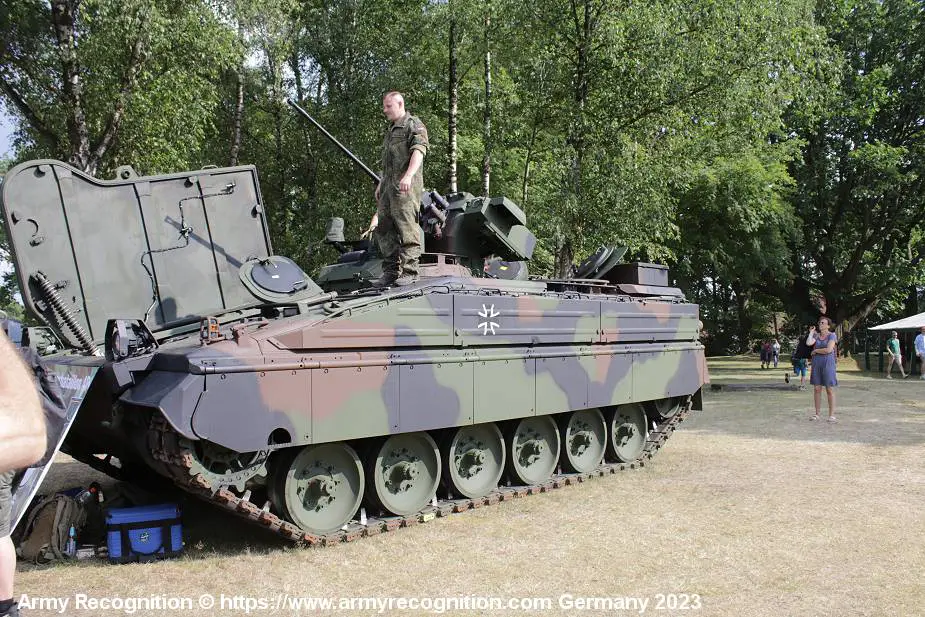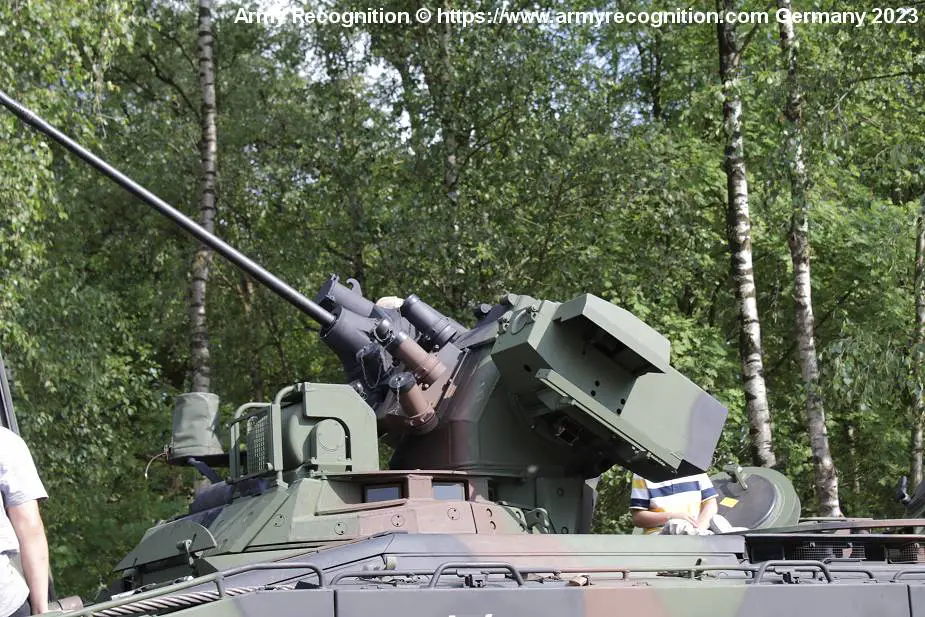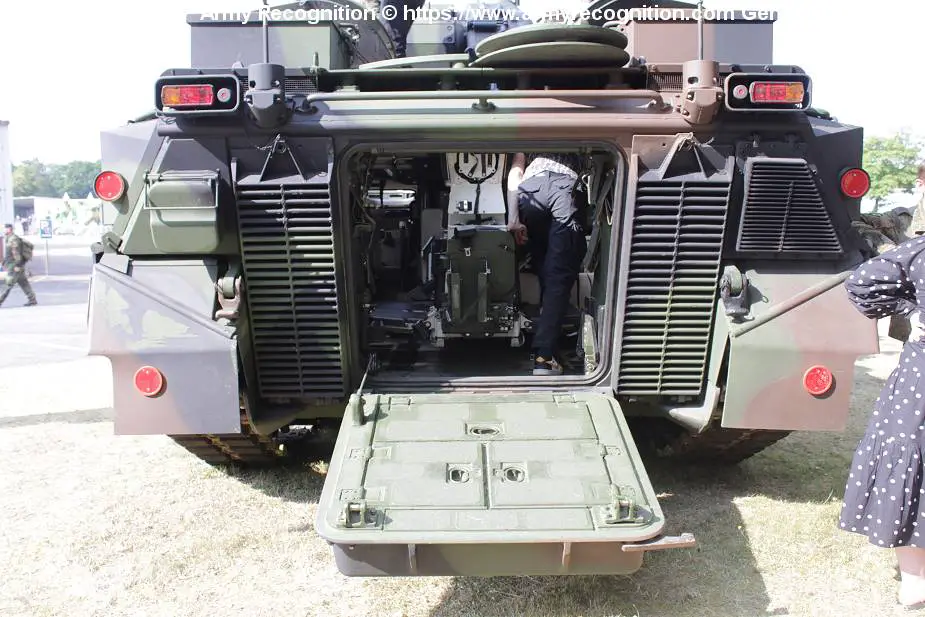The modernization of the German Marder IFV to the Marder 1A5 and 1A5A1 standards is a strategic move by the German military to ensure the continued operational relevance and capability of these armored fighting vehicles. This effort reflects the ongoing global trend of extending the service life of existing military hardware through targeted upgrades that enhance performance and survivability.
Follow Army Recognition on Google News at this link

The German-made Marder 1A5 is considered as one of the most modern IFV Infantry Fighting Vehicles in the world. (Picture source Army Recognition)
Marder 1A5
The key upgrade in the Marder 1A5 standard focused on improving the protection against mines. In light of increasing threats posed by IEDs and mines in modern warfare, additional anti-mine armor was added to the Marder 1A5, which was designed to mitigate the force of a mine blast and protect the crew. This was combined with a complete interior remodeling aimed at reducing blast and shock injuries to the crew.
This modification also included enhanced floor clearance in the fighting compartment, a new stowage concept, and improved brakes and ventilation systems. The armor skirts were upgraded with steel, and the previous conical compression springs were replaced with hydraulic buffers, which can more effectively absorb shocks.
Marder 1A5A1
Continuing with the upgrading process, the Marder 1A5A1 saw further enhancements in crew comfort, survivability, and operational effectiveness. This version included an air conditioning system, reflecting a growing understanding of the importance of crew comfort for operational performance in modern military vehicles. Moreover, a jammer for IED protection was added, providing another layer of defense against this prominent threat.
The vehicle was also equipped with multi-spectral camouflage, providing improved concealment capabilities against varying sensor technology. Additionally, the Marder 1A5A1 was equipped with protective structures around the roof hatches and a new driver's vision system (SPECTUSS) that utilizes Spectral Technology for Unlimited Sight.
The CG-12 electronic countermeasures protective equipment was also added to increase the vehicle's resilience against electronic warfare threats. This upgrade shows an understanding of the increasingly network-centric nature of modern warfare, where electronic warfare capabilities can significantly impact the outcome of a battle.

The Marder 1A5 is armed with one 20mm automatic cannon, one 7.62mm coaxial machine gun, and the new MELLS anti-tank guided missile launcher. (Picture source Army Recognition)
Weapon Upgrades
The armament of the Marder IFV was also upgraded in these versions. While the 20mm automatic and one 7.62mm coaxial machine gun were retained, the previous Milan anti-tank guided missile launcher was replaced by the MELLS, a German version of the Israeli Spike missile from Eurosspike. This system is designed for engaging armored ground targets at extended ranges, significantly improving the Marder's anti-armor capabilities. MELLS is a versatile, lightweight guided missile system designed specifically to engage armored ground targets. It boasts a maximum effective range of up to 4,000 meters, which extends to 5,500 meters when using the upgraded Spike long-range (LR) guided missile, produced by Rafael Advanced Defense Systems.
Armor
The Marder 1A5 received significant upgrades to its armor as part of its modernization. The most crucial among these was the addition of extra anti-mine armor. This armor is specifically designed to provide protection against blast and projectile-forming mines, which are significant threats in modern combat scenarios.
The additional anti-mine armor serves to absorb and distribute the energy from a mine blast, thereby reducing the potential for penetration into the vehicle's interior. This would not only protect the vehicle's vital components but more importantly, reduce the likelihood of direct harm to the crew.
The interior of the Marder 1A5 also underwent significant remodeling to further increase crew survivability in the event of a mine blast. This involved an altered stowage concept to prevent loose equipment from becoming hazardous in a blast scenario. It further enhances crew safety by reducing the chance of secondary injuries caused by loose items within the vehicle's interior being thrown around by the force of an explosion.
In addition, increased floor clearance in the fighting compartment was implemented. This design modification is crucial in lessening the impact of a mine detonation. By increasing the distance between the crew and the blast point, the impact of the blast wave is lessened before it reaches the crew.
One of the most notable enhancements in the Marder 1A5 upgrade is the introduction of anti-mine blast seats. These seats are not affixed to the floor of the vehicle, which is a significant improvement over conventional designs. The purpose of this design is to isolate the crew from the shock wave that travels through the vehicle's structure when a mine detonates beneath it. This helps to significantly reduce the risk of injury or death from the vertical acceleration caused by a mine blast.

The interior of the Marder 1A5 also underwent significant remodeling to further increase crew survivability in the event of a mine blast. (Picture source army Recognition)
Optics and Sensor
Upgrades The Marder 1A5 saw the installation of new thermal imaging sights in June 2021. The Saphir 2.6 MK (Marder configuration) thermal imaging sight, developed by Rheinmetall Electronics, significantly extended the observation range and reconnaissance quality of the vehicle both day and night. The integration of this advanced imaging system, coupled with the new Marder driver night vision devices, not only improves the survivability of the Marder but also confers considerable tactical advantages to the crew by enhancing their situational awareness.
Service Life Extension and Weight
These upgrades are part of the German military's strategy to extend the Marder IFV's service life until at least 2030. However, these improvements do come with an increased weight. While the original Marder IFV has a combat weight of 28.5t, the 1A5 and 1A5A1 variants weigh 37.4t and 38.1t respectively. This weight increase could potentially reduce mobility or increase logistical challenges but seems to have been considered an acceptable trade-off for the improved capabilities. In summary, the upgrades to the Marder IFV reflect the changing nature of the battlefield and the need to adapt existing platforms to meet these new challenges. By investing in targeted upgrades, the German military has significantly enhanced the Marder's survivability, operational capabilities, and service life.
















